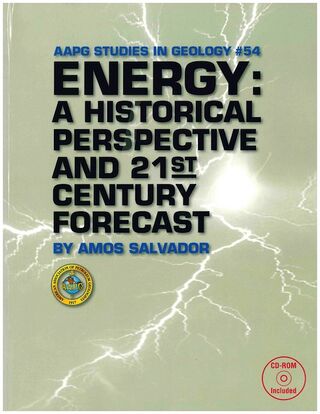Gas hydrates
| Energy: A Historical Perspective and 21st Century Forecast | |

| |
| Series | Studies in Geology |
|---|---|
| Chapter | Sources of Energy |
| Author | Dr. Amos Salvador |
| Link | Web page |
| PDF file (requires access) | |
Gas hydrates have been commonly mentioned as potentially vast sources of natural gas. The high cost and the technical, operational, and environmental problems of recovering gas from these reservoirs make them unlikely sources of gas for many years to come, certainly as long as cheaper, more redily produced sources of gas are available.
Gas hydrates (also called gas clathrates) are icelike, crystalline solids composed of natural-gas molecules, principally methane, trapped in rigid crystalline cages formed by frozen water molecules. They are known to be stable under conditions of high pressure and low temperature that have been recognized in polar regions at depths from 130 to 2000 m (425 to 6500 ft), where temperatures are low enough for the formation of permafrost, and in the uppermost part of deep-water sediments below the sea floor at depths of more than 100-1100 m (330-3600 ft).[1] [2] Most methane in gas hydrates is of microbial origin, although some is believed to be the result of thermogenic processes.[3] [4] [5] KvenvoldenCite error: Closing </ref> missing for <ref> tag If this estimate is correct, he states that
...the amound of methane carbon in gas hydrates is a factor of two larger than the carbon present in known fossil fuel deposits (coal, oil, and natural gas).[6]
References
- ↑ Collett, T. S., 2001, Natural-gas hydrates: Resources of the twenty-first century?, in M. W. Downey et al., eds., Petroleum provinces of the twenty-first century: AAPG Memoir 74, p. 85-108.
- ↑ Collett, T. S., 2002, Energy resource potential of natural gas hydrates: AAPG Bulletin, v. 86, no. 11, p. 1971-1992.
- ↑ MacDonald, G. J., 1990, The future of methane as an energy resource: Annual Review of Energy, v. 15, p. 53-83.
- ↑ Kvenvolden, K. A., 1993, A primer on gas hydrates, in D. G. Howell, ed., The future of energy gases: U.S. Geological Survey Professional Paper 1570, p. 270-291.
- ↑ Kvenvolden, K. A., 1993, Gas hydrates as a potential energy resource-A review of their methane content, in D. G. Howell, ed., The future of energy gases: U.S. Geological Survey Professional Paper 1570, p. 555-561.
- ↑ Kvenvolden, K. A., 1993, Gas hydrates as a potential energy resource-A review of their methane content, in D. G. Howell, ed., The future of energy gases: U.S. Geological Survey Professional Paper 1570, p. 559.